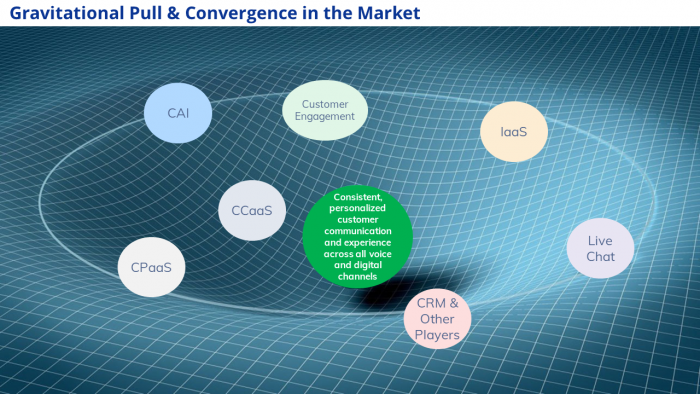The writing is on the wall for CCaaS solutions, even if it’s hard to read at the moment. As today’s standard, CCaaS grew out of the classic voice and hardware era of contact centers, transitioning organizations from managing hardware and software locally, to the cloud. In essence, it was simply lift and shift.
Yet, the unspoken and seemingly unchallenged assumption is that customer service as a concept, revolves around contact centers and phone calls, i.e. human-to-human interaction. One of the basic premises and assumptions of CCaaS is the primacy of the phone call and all the connectivity, routing and management that they require. Today, we’re seeing a slow convergence between CCaaS, UCaaS, CAI, CRM, Digital Engagement and other related solutions towards a single goal: consistent, personalized customer communication and experience across all voice and digital channels.
Why?
In the past, companies competed by cost or quality, selling either lower-cost products or services than competitors, or higher quality ones. But, as customers interact with businesses digitally, shopping and working from home, ordering things online and via apps and having them delivered via 3rd parties, the end-to-end customer experience has become the main battleground to win and retain customers. Even physical stores themselves are shifting from serving the masses to delivering a a more narrow tailored experience in combination with their digital presence.
But first a word from my nonexistant sponsors:
This is a personal opinion, in no way representing my employer or anyone else. My aim isn’t to make a hard prediction but look at the underlying assumptions behind CCaaS and contact centers, why they are no longer valid and what that means for a very diverse yet converging vendor landscape and where contact center tech may be headed.
Navigating with Yesterday’s Compass
CCaaS solutions are cloud-delivered software for managing conversations, usually in multiple channels. They support inbound and outbound contacts, routing, reporting and more. While technically speaking, voice isn’t even a requirement for a CCaaS solution, it’s still been the guiding principle, meaning CCaaS is typically the central pillar of modern contact centers.
With CCaaS growing and innovating rapidly, vendors are also including related solutions like workforce management or basic bots.
However, we’re already seeing a move toward self-service first and human-to-human interactions second, only for more complex value added cases, not simple informational and transactional requests. At the moment, most people either consciously or unconsciously view self-service channels as additional and often as a means towards cost reduction.
Working Assumptions
To be clear for readers, I will assume the following:
- Voice volume will slowly decrease as a communication channel (but never disappear)
- Voice will be the primary channel for complex, high value issues and edge cases
- Self-service will be the consumer preferred option and primary method of service
- Virtual agents in voice and text form and the underlying AI + NLU will continue to improve
- Customers will increasingly accept virtual agents
- Customer service agents will increasingly work remotely
Peak CCaaS
With Salesforce recently entering the CCaaS game along with other non-traditional players like Microsoft and Amazon, not to mention ancients like WebEx trying to get in on the action, we seem to be reaching a point where CCaaS is no longer a niche product by pure players, but another must-have component in any platform vendor’s portfolio.
Yet, we know from experience that most platform players excel at their core business and the rest is a hodge podge of MVP features and acquisitions. This usually means a rather messy behind the scenes experience (e.g. Salesforce) and components which cover minimum needs for everyone while not actually meeting anyone’s specific needs.
Additionally, CCaaS, CPaaS, CAI and others are all gravitating towards each other in terms of functionality, target markets and messaging. I may be simplyfing some, but let’s play guess the vendor here.
- “Personalized communication at every step of the customer journey.”
- “Create a seamless customer journey across channels that is fast and frictionless. Explore our automation-first solutions with AI for every day.”
- “Transform your customer experience. Create the exact solution you need to engage customers at every step of their journey.”
- “Provide convenient, timely, and personalized service experiences for your customers and employees.”
- “Customers want to connect any time, any place. Meet them where they are with the Zendesk Suite, which provides sophisticated, seamless support that flows across channels.”
Can you identify which message is from a CPaaS, CCaaS, CAI and Customer Engagement Center provider? I sure can’t. Here are the answers:
- CPaaS
- CCaaS
- CPaaS
- CAI
- Customer Engagement
So the common denominator here is that everyone is moving towards consistent, personalized customer communication and experience across all voice and digital channels. Vendors have also been on acquisition spree bolstering their core business with AI, knowledge management, social and messaging capabilities and workforce management. Thus, we see everyone is converging as the gravity of that market need pulls multiple categories of solution together slowly.
What does that tell us about the market?
- Customers want frictionless, personalized customer experiences
- The market is overwhelmingly aligned on this from businesses to vendors
- Vendors across the board are actively working on holistic solutions
- It’s becoming increasingly difficult to differentiate vendors, even across categories
- The market will continue to converge and consolidate in the near future
Where is it Going from Here?
When we flip the script and treat self-service as the first and primary touch point and the ability via software to accomplish most simple and some complex tasks, CCaaS no longer looks like the logical starting point. I’ve sketched out four possible scenarios based on two variables, technology and the market and whether they converge or diverge.
Stay tuned for part two!





